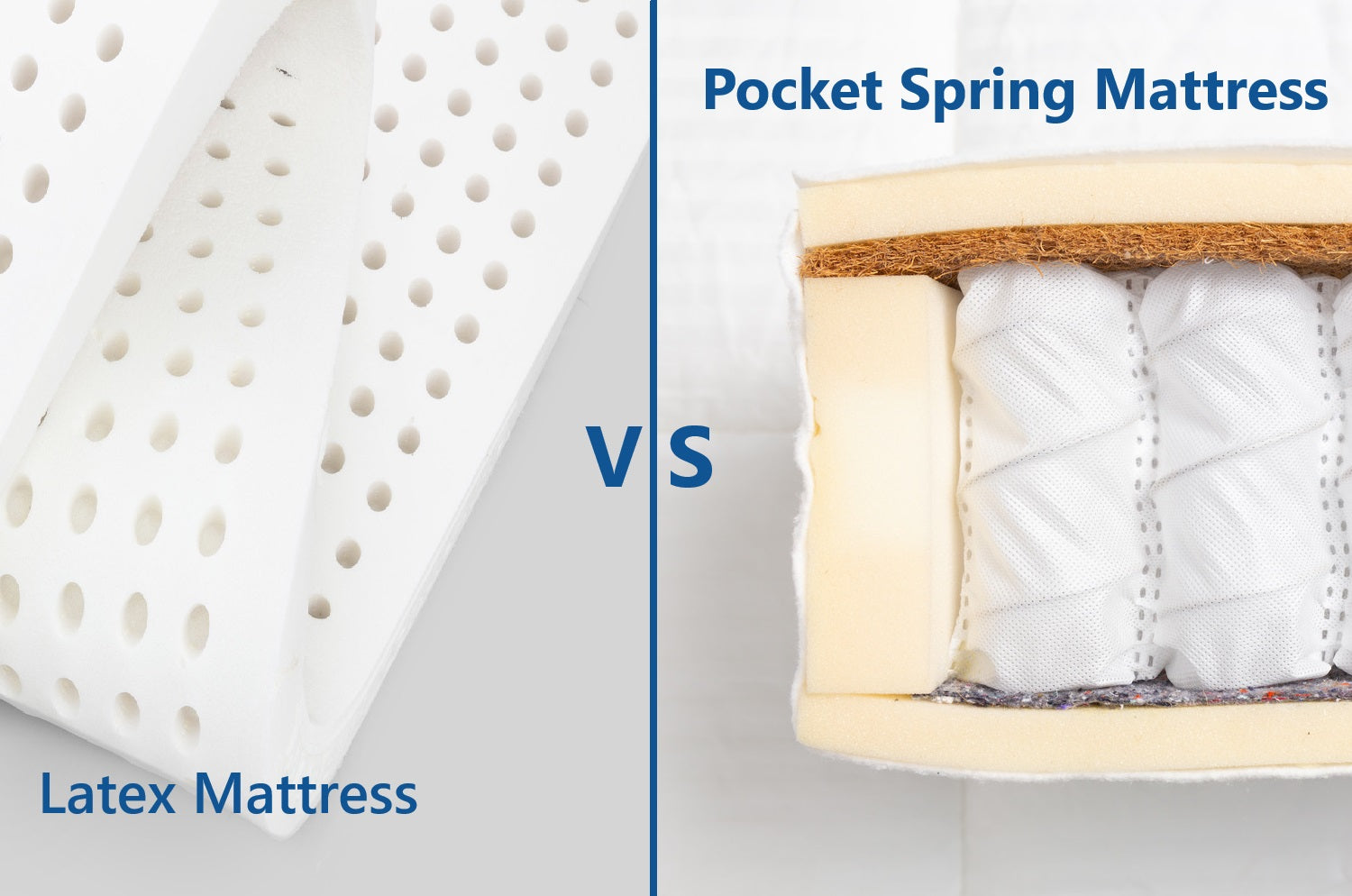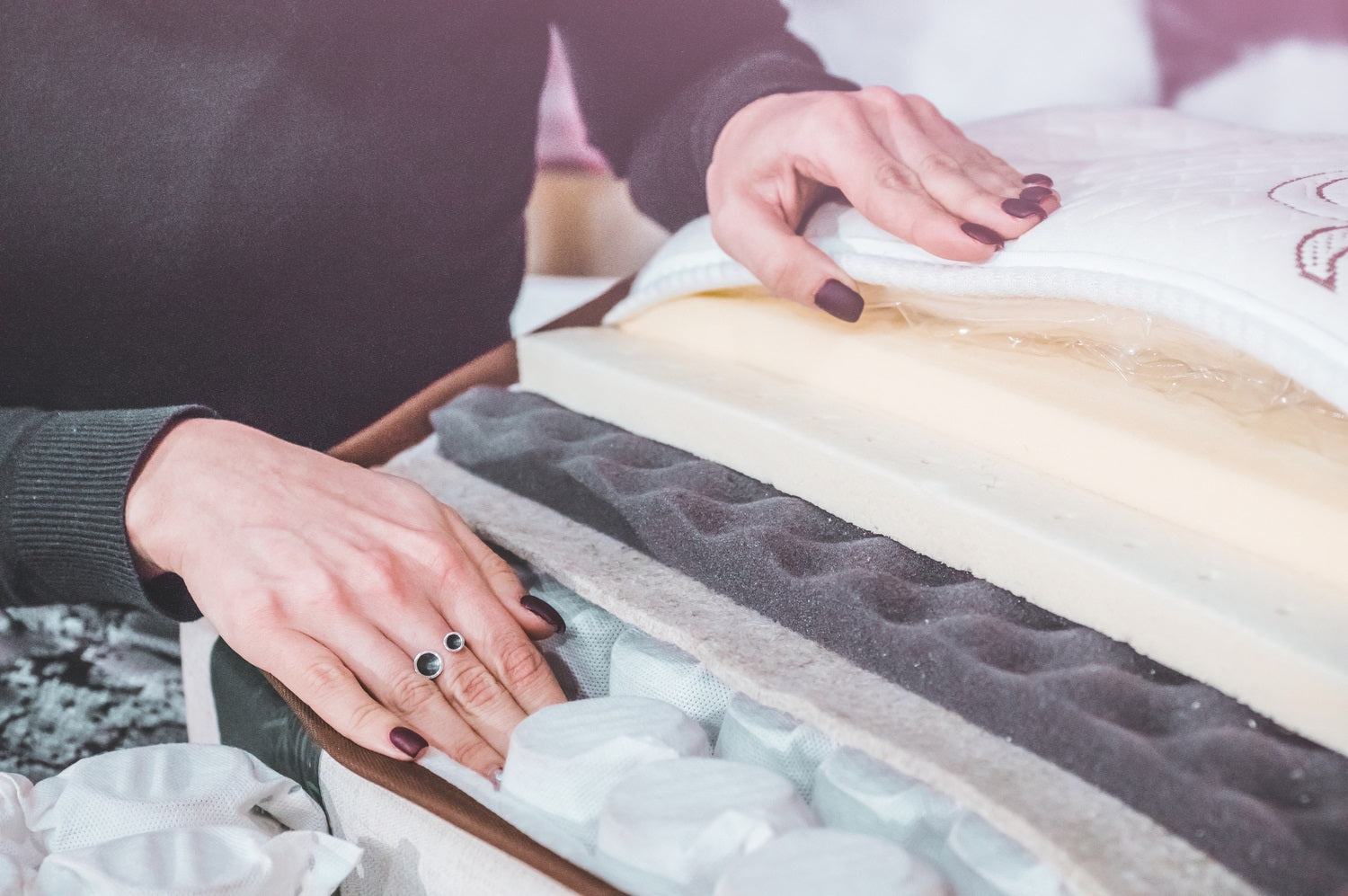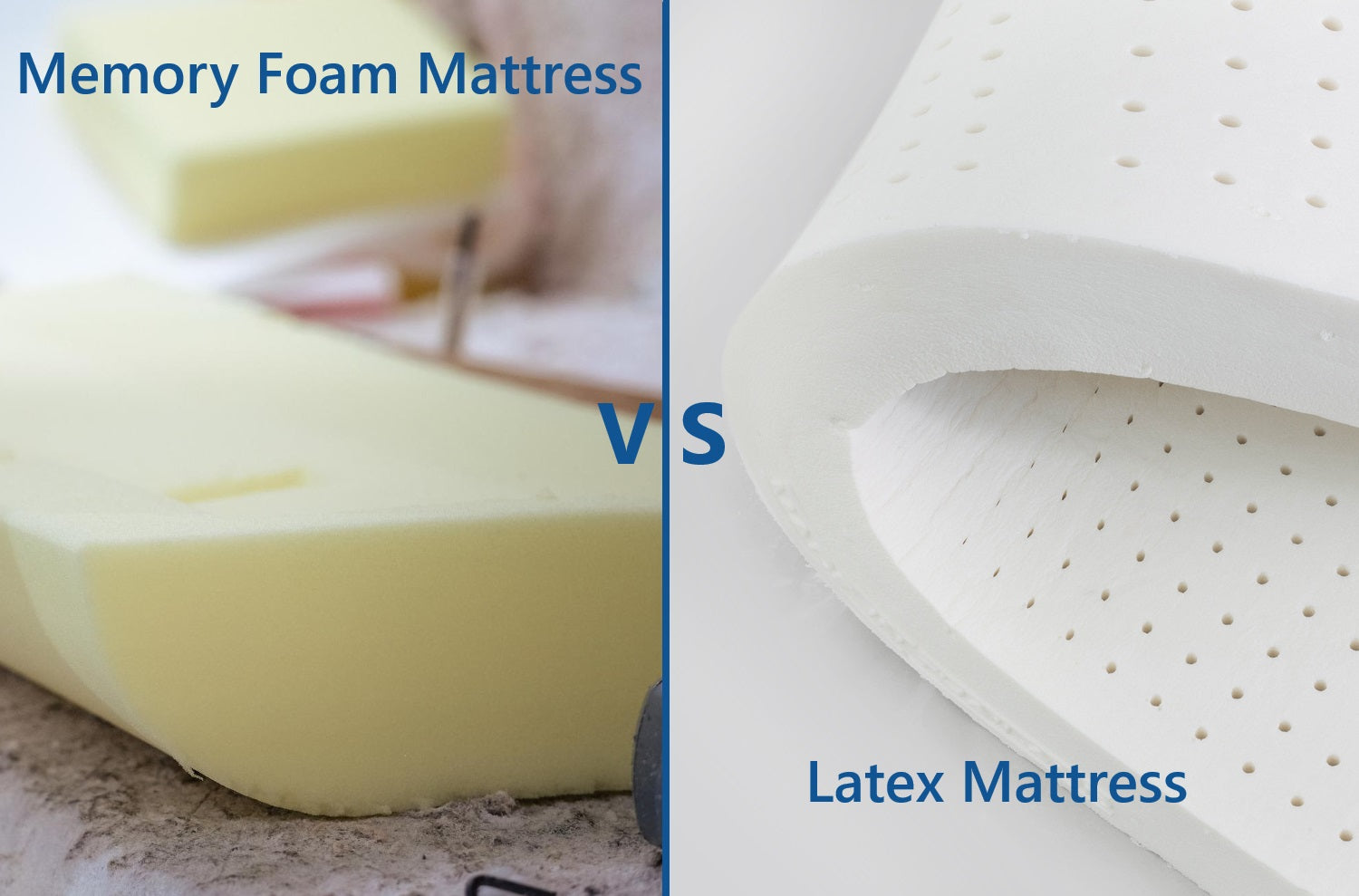If you’re shopping for a new mattress and wondering which type will suit your needs, climate, and lifestyle, you’re in the right place. In this post, we’ll explore how Cyprus’s unique weather and daily routines influence mattress selection and break down the key differences between natural latex and pocket spring mattresses.
You’ll learn why latex mattresses are valued for their eco-friendliness, durability, and lasting support, making them an excellent option for those seeking long-term comfort. We’ll also examine pocket spring mattresses, which are often more affordable and provide targeted support with a softer feel.
By the end of this article, you’ll have a clear understanding of the pros and cons of each mattress type—helping you make an informed decision for your best night’s sleep in Cyprus.
What is a latex mattress?
A latex mattress is made mainly from latex foam, which can be either natural (sourced from rubber tree sap) or synthetic. Natural latex is eco-friendly, durable, and breathable, while synthetic latex is more affordable but generally less long-lasting.
Natural latex is processed using either the Dunlop method (which produces a denser, firmer foam) or the Talalay method (resulting in a lighter, softer feel). Some mattresses combine natural and synthetic latex to strike a balance between cost and comfort.
Typically, a latex mattress features a latex core—sometimes with layers of varying firmness for targeted support—covered by a breathable fabric like organic cotton. Latex mattresses are resilient, contour to the body, and naturally resist allergens such as dust mites and mould.
What is a pocket spring mattress?
A pocket spring mattress is made with hundreds or even thousands of individual steel springs, each enclosed in its own fabric pocket. These springs move independently, so the mattress can respond to your body’s shape and weight.
The top layer is usually made from materials like memory foam or latex, which add comfort and softness to the surface. The overall feel of the mattress depends on the number of springs and the types of materials used above them.
What are the differences between latex and pocket spring mattresses?
When comparing latex mattresses and pocket spring mattresses, the primary difference lies in the materials used to make them. This also affects how they work. Latex mattresses are made from all-natural or synthetic latex. They have steadier firmness, and the material does not cause allergies easily. This is beneficial for individuals with allergies or back pain.
On the other hand, pocket spring mattresses use coils inside for bounce and some motion isolation. They are usually lighter and cost less at first. However, they may not last as long or be as environmentally friendly as natural latex mattresses.
Picking the correct mattress means finding what feels good for you and what works best for your body.
1. Material differences between latex and pocket spring mattresses
Material differences between latex and pocket spring mattresses are fundamental to how each mattress feels, performs, and lasts.
Here’s a detailed comparison based on the latest expert sources:
Latex Mattresses:
-
Core Material: Made primarily from natural latex (extracted from rubber tree sap) or synthetic latex. High-quality mattresses utilise 100% natural latex, prized for its eco-friendliness, resilience, and hypoallergenic properties.
-
Structure: The entire core is latex foam, sometimes layered for varying firmness. No springs or coils are present.
-
Comfort Layer: The latex itself serves as both support and comfort, offering a buoyant, responsive, and pressure-relieving surface.
-
Breathability: Natural open-cell structure allows for excellent airflow and temperature regulation.
-
Allergy Resistance: Naturally resistant to dust mites, mould, and bacteria, making it ideal for allergy sufferers.
-
Eco-Friendliness: Natural latex is a renewable, biodegradable material that is free from harmful chemicals and off-gassing.
-
Durability: Can last 10–20 years without sagging, maintaining shape and support much longer than most spring mattresses.
Pocket Spring Mattresses:
-
Core Material: It contains hundreds to thousands of individually wrapped steel springs (“pockets”) that move independently for targeted support.
-
Structure: Springs form the support core, usually topped with comfort layers made of foam, latex, or fiberfill for added softness and pressure relief.
-
Comfort Layer: The feel is heavily influenced by the type and thickness of the top layer (foam, latex, or other materials).
-
Breathability: Airflow is good between springs, but heat can build up if the comfort layer is thick foam. Breathable covers can help.
-
Allergy Resistance: Not naturally hypoallergenic; may require chemical treatments or special covers to reduce allergens.
-
Eco-Friendliness: Most products use synthetic foam adhesives, which are not biodegradable.
-
Durability: Typically lasts 7–10 years; springs and padding may wear out or sag sooner than latex, especially in lower-quality models.
-
Noise: Springs may creak or squeak over time, unlike silent latex mattresses.
Latex mattresses are made from solid latex foam and excel in durability, breathability, and hypoallergenic properties. Pocket spring mattresses feature a core of individually wrapped coils combined with various comfort layers, providing a traditional bouncy feel and customizable support. However, they may not match latex mattresses in terms of longevity or allergy resistance.
2. Support differences between latex and pocket spring mattresses
The differences between latex and pocket spring mattresses stem from their construction and how they respond to body weight, movement, and pressure points.
Here’s an expert breakdown based on the latest findings:
|
Feature |
Latex Mattress |
Pocket Spring Mattress |
|---|---|---|
|
Support Type |
Consistent, uniform, adaptive |
Zoned, targeted, customizable |
|
Spinal Alignment |
Excellent, adapts to body shape |
Very good, especially with zoned systems |
|
Pressure Relief |
Superior, even weight distribution |
Good, varies with coil count and comfort layers |
|
Responsiveness |
Quick, buoyant, springs back instantly |
Bouncy, but support can be uneven under heavy areas |
|
Edge Support |
Good |
Often excellent |
|
Motion Isolation |
Excellent |
Good, but some transfer possible |
|
Long-Term Stability |
Maintains support for many years |
Springs can wear out or sag over time |
Latex mattresses excel at providing consistent, adaptive support and pressure relief across their entire surface, making them ideal for those who want steady spinal alignment and minimal disturbance from their partner.
Pocket spring mattresses offer highly customizable, zoned support and strong edge reinforcement, providing a traditional bouncy feel—ideal for those who prefer targeted support or sleep with a partner. However, they have slightly less uniformity and motion isolation than latex.
3. Durability differences between latex and pocket spring mattress
Latex mattresses are significantly more durable than pocket spring mattresses, offering a much longer lifespan and better long-term performance.
-
Natural latex mattresses typically last 10 to 20 years or more without sagging or losing their supportive qualities. Latex is highly resilient, maintaining its shape and resisting body impressions, making it a top choice for those seeking a long-term investment in sleep comfort.
-
Pocket spring mattresses generally last 7 to 10 years, depending on the quality of the springs and comfort layers. Over time, the springs can lose tension, and the foam or padding above them may compress or sag, leading to reduced support and comfort. Cheaper models tend to wear out faster, and many buyers replace them sooner due to sagging or loss of support.
If durability and longevity are your priorities, latex mattresses clearly outperform pocket spring mattresses, making them a better long-term investment for most sleepers in Cyprus.
4. Allergy suitability differences between latex and pocket spring mattresses
Latex mattresses are significantly more suitable for allergy sufferers compared to pocket spring mattresses.
Latex Mattresses:
-
Naturally hypoallergenic: Natural latex is inherently resistant to dust mites, mould, and mildew, making it an excellent choice for people with allergies or asthma.
-
Antibacterial and antifungal: The material’s structure and natural properties deter the growth of bacteria and fungi, promoting a cleaner and healthier sleep environment.
-
No harmful chemicals: High-quality natural latex mattresses are free from added chemicals and volatile organic compounds (VOCs), reducing the risk of chemical sensitivities.
-
Excellent ventilation: The open-cell structure of latex allows for superior airflow, which helps keep the mattress dry and further discourages allergen buildup.
-
Dense and non-porous: Latex’s dense structure makes it difficult for dust mites to burrow and thrive, providing an extra layer of protection for allergy sufferers.
Pocket Spring Mattresses:
-
Not naturally hypoallergenic: Pocket spring mattresses can harbour dust mites and allergens, especially within their padding and comfort layers.
-
Better airflow than traditional springs: The design allows for improved ventilation compared to standard spring mattresses, which can help reduce moisture and allergen retention but does not eliminate the risk.
-
Chemical treatments may be necessary: Some pocket spring mattresses utilise anti-dust mite or antimicrobial treatments to enhance allergy resistance; however, these may introduce chemicals that could irritate sensitive individuals.
-
Cover materials matter: Choosing a pocket spring mattress with a hypoallergenic cover (such as Tencel or organic cotton) and regular cleaning can help reduce allergens, but the core is still more susceptible than latex.
Natural latex mattresses are the superior choice for allergy sufferers thanks to their inherent resistance to dust mites, mould, and bacteria, as well as their chemical-free composition and excellent breathability. Pocket spring mattresses can be improved for allergy control with special covers and treatments. Still, they do not match the natural hypoallergenic benefits of latex.
5. Noise differences between latex and pocket spring mattresses
Noise differences between latex and pocket spring mattresses are significant. They can impact sleep quality, especially for light sleepers or couples.
Latex Mattresses:
-
Virtually Silent: Natural latex mattresses are made from solid foam with no moving parts, so they do not produce noise—even after years of use.
-
No Squeaks or Creaks: Whether you move, shift, or get in and out of bed, latex remains whisper-quiet, allowing for undisturbed sleep.
-
Consistent Performance: The absence of springs means latex mattresses maintain their silent performance throughout their lifespan.
Pocket Spring Mattresses:
-
Potential for Noise: Pocket spring mattresses contain hundreds or thousands of individually wrapped steel coils, which can create a noticeable noise when in use. Over time, these springs may rub against each other or become misaligned, causing squeaks or creaks when you move or put weight on the mattress.
-
Quality Matters: High-quality pocket spring mattresses are designed to minimise noise, especially when new. However, even the best models can develop some noise as the springs age or if manufacturing defects are present.
-
Age and Wear: Noise is more likely to develop as the mattress ages or if its springs or padding wear out.
Latex mattresses are silent and ideal for those seeking a noise-free sleep environment. Pocket spring mattresses may start quietly but can develop squeaks and creaks over time due to their coil system, particularly as they age or if the springs become misaligned or worn.
6. Best-use differences between latex and pocket spring mattresses
Best-use differences between latex and pocket spring mattresses centre on sleep preferences, health needs, and budget. Here’s how each type excels in different situations:
|
Mattress Type |
Best Use Cases & Sleepers |
Key Benefits |
Considerations |
|---|---|---|---|
|
Latex Mattress |
- Allergy sufferers |
- Naturally hypoallergenic and resistant to dust mites, mold, and bacteria |
- Higher initial cost |
|
Pocket Spring Mattress |
- Back and stomach sleepers |
- Responsive, lively feel |
- May not last as long (7–10 years) |
Your ideal choice should reflect your sleep style, health needs, and budget priorities in Cyprus’s climate.
What are the overall pros and cons when comparing latex and pocket spring mattresses?
When comparing latex and pocket spring mattresses, each offers unique advantages and drawbacks that suit different sleep needs and preferences.
Here’s a concise breakdown of their main pros and cons:
|
Feature |
Latex Mattress |
Pocket Spring Mattress |
|---|---|---|
|
Pros |
- Extremely comfortable and supportive |
- Good support and pressure relief, especially with quality springs |
|
Cons |
- Higher initial cost |
- Shorter lifespan (7–10 years) |
Your choice should depend on your priorities: long-term durability and health benefits (latex) versus affordability, bounce, and ease of movement (pocket spring).



